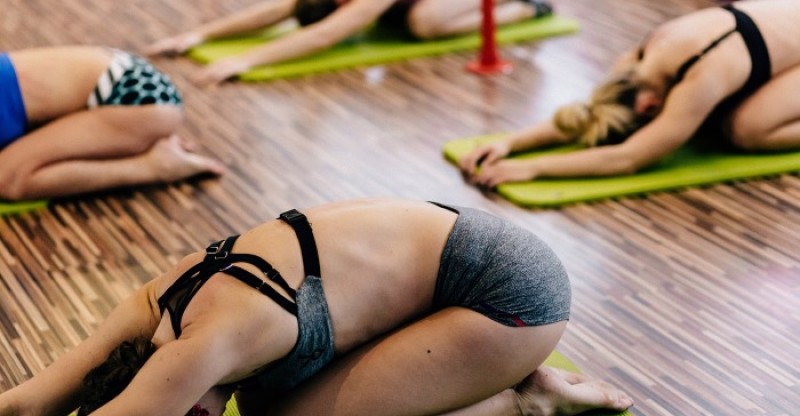The Beginner’s Guide to Yoga
The ancient practice of yoga is not just another fitness craze — this 5,000-year-old (or older) practice is here to stay, and for good reason.
Over 36 million Americans (1) are investing in this mind-body practice and reaping the widely known health benefits, including decreased stress and anxiety, reduced chronic neck and back pain, improved balance and brain function, and increased flexibility, among others.
Why Practice Yoga?
Yoga is an all-encompassing mind and body practice, combining physical postures, breathing exercises, and meditation.
Contrary to the common belief that yoga is solely a practice to gain flexibility, research has demonstrated monumental emotional and mental benefits (2) associated with the practice of yoga.
With such a strong emphasis on breath, yoga practitioners will experience reduced stress and anxiety, better quality sleep, a heightened awareness of the body, and improved concentration, among many other benefits.
Both controlled and uncontrolled studies evaluating the effects of yoga concluded an improvement in mood (3) among the elderly and people with mental disorders like bipolar disorder, schizophrenia, and depression.
If better sleep and improved mood aren’t reasons compelling enough to get you on your mat, then consider the positive impacts of awareness and mindfulness.
With so much of the practice bringing attention to the breath, practitioners develop a strong sense of inner awareness and become innately connected to their bodies.
In fact, one study found that people practicing yoga demonstrated higher levels of satisfaction with their bodies, which supports the idea that yoga promotes positive body image (4) and increased confidence.
Further, the mindfulness component is greatly impactful and transferable in all areas of the practitioner’s life — including eating.
People who practice yoga are often mindful eater (5) — they have an acute awareness of the physical and emotional sensations triggered by food, and they tend to not overeat or make poor food choices when compared to non-practitioners.
With so many studios and variations of yoga, it can be overwhelming trying to determine which style suits you best.
I would highly suggest taking the time to explore each individual style, and you should consider trying different instructors if your first experience isn’t meeting your expectations.
Much of the practice is contingent upon the instructor’s teaching style, so that could be the difference between the most amazing and worst practice of your life.
Types of Yoga
For the beginner looking to find the right fit, below is a breakdown of the different styles and a description of what you can expect from each.
Hatha Yoga
Hatha is the practice of uniting physical yoga postures and breath (6), calming the body and mind.
It encompasses the following styles:
- Ashtanga (“eight-limbed yoga”)
What is it: This is a rigorous and physically challenging style of yoga that begins with chanting and follows the same sequence of poses each time.
You can expect to be in a heated room of 80 to 90 degrees, moving quickly and sweating profusely.
Movement and breath are synchronized, and the intention is to build an internal fire, so have a towel and water bottle nearby!
Skill level: All levels.
Ideal for: People interested in building strength and endurance, being physically challenged, and being a part of a community.
- Power Vinyasa
What is it: Vinyasa, one of the most popular styles of yoga, is a fast-paced, sequence-oriented style that synchronizes breath with movement.
The word “Vinyasa” specifically refers to the three poses — high plank, low plank, and upward dog — that are used to create flow, serving as a link from one pose to the next.
There is attention to form and alignment, and depending on the instructor, you may experience a vigorous, high-intensity practice.
Skill level: All levels.
Ideal for: People who enjoy movement, freedom of expression, and unpredictability.
- Iyengar
What is it: Under the umbrella of Hatha yoga, Iyengar (7) encourages the use of props, like blocks, straps, and bolsters, to attain proper alignment in every pose.
Instructors are generally trained in biomechanics and pay attention to detail, emphasizing modifications to help avoid or alleviate pain due to injury.
This style of yoga differs from Vinyasa and Ashtanga in that it does not get the heart rate high and is often prescribed for people recovering from neck or back problems (8).
Skill level: All levels.
Ideal for: People who are looking for a slower-paced practice or are recovering from injuries and/or chronic conditions.
Bikram Yoga
What is it: The original hot yoga (9), this style involves a series of 26 poses that are done repetitively in 100-degree (or hotter) temperatures.
All classes consist of the same 90-minute sequence, making it easy for the traveling yogi to pop into any Bikram studio and know exactly what they can expect.
Despite the popularity of this yoga style, it’s not for everyone, especially for older adults who might not have the ability to thermoregulate as easily.
Skill level: All levels, but ideal for beginners because the sequence never changes
Ideal for: People who like heat, humidity, and no surprises.
Kundalini Yoga
What is it: Translated from Sanskrit as “coiled snake,” Kundalini yoga is often referred to as “yoga of awareness.”
Classes are 60–90 minutes, honing in on the breath, as well as activation and movement of energy centers and alignment of the chakras.
This style requires a lesser degree of physical exertion but does include chanting, meditating, and holding postures.
Skill level: All levels.
Ideal for: People who are looking for a deeper practice and spiritual connection without a physically challenging practice.
Restorative Yoga
What is it: Like the word suggests, Restorative yoga is a style that promotes restoration.
Unlike the other types of yoga, this form focuses on physical, mental, and emotional relaxation through a series of five to six poses with the use of props.
This is a great all-levels style that works especially well when paired with meditation (10) as you’re winding down for the evening.
Skill level: All levels.
Ideal for: People looking for a healing practice, as well as those recovering from illness, injury, depression, anxiety, or insomnia.
Kripalu
What is it: Kripalu is a three-part practice that focuses on meditation, breathwork, and spiritual awareness.
It begins with exploring how your body responds to different poses, moves through holding those poses for an extended period of time, and ends with meditation.
Skill Level: All levels.
Ideal for: People looking to transform their lives.
Yin Yoga
What is it: This is a slow-paced, passive practice of yoga that targets the deep connective tissues and fascia.
This Daoist style involves a variation of seated and supine postures that are held for three to five minutes with the intention of regulating the body’s flow of energy.
Skill Level: All levels.
Ideal for: People recovering from addictions, trauma, anxiety, or eating disorders.
Acro Yoga
What is it: A combination of yoga, Thai massage, and partner acrobatics, this style of yoga is known as the “yoga of trust.”
Skill Level: All levels.
Ideal for: People wanting to practice the art of trust and become a part of a community.
Which Yoga Style Is Best for You?
With so many variations and hybrids of yoga, how do you choose the practice that will best serve your needs?
Here are some important factors to take into consideration as you start looking.
First, identify why you want to practice.
Are you looking for an intense physical practice or are you recovering from an injury and need something restorative?
Knowing your “why” will help you narrow your options down to specific styles that will match your needs.
There are classes that will have a slower flow with longer holds as opposed to classes that will move you more quickly and offer more intensity.
Some studios will have one or the other, while others will have a combination of styles depending on the instructor.
In addition to identifying your “why”, you should be mindful of what you’re hoping to gain — whether it be flexibility, a spiritual experience, or stress reduction.
Second, recognize what your preferences are — are you looking to become a part of a community or do you want something more personalized and catered specifically to meet your individual goals?
I would highly suggest trying different studios and teachers and journaling your experience — physical, mental, and emotional.
A good yoga class will help create a safe and supportive environment where the instructor will respect your limitations while helping you discover your edge and safely pushing you beyond your comfort zone.
There is also a huge emotional component that should not be overlooked.
It’s common to turn to yoga when you’re experiencing challenging life events as a means to gain clarity and become grounded.
Finding an authentic instructor who inspires you, empowers you, and leaves you in your greatness is of utmost importance.
More often than not, students return based on the connection they feel with the instructor.
How to Practice Yoga Safely
When you’re a beginner, yoga can be an intimidating practice.
Some classes move quickly and have more poses than one can count, while others are slower yet more advanced, focusing on aligning breath and movement.
Rather than getting overwhelmed and discouraged, follow these tips to develop a safe and effective practice:
- Begin with intro and beginner classes. You have to learn to crawl before you can learn to walk, so ease yourself into classes that will break down each pose and teach you proper alignment and form. Creating a strong foundation is key to any powerful practice.
- Become acutely aware of your body in each pose. Awareness is one of the most important elements in any yoga practice, as it not only makes you present but also helps you listen to and honor your body to maintain a safe practice. Listening to your body allows you to respond appropriately. If a pose is causing you a sharp, shooting pain, it’s a good indication that you should back off and consider taking a modification.
- Remember that “comparison is the thief of joy.” Don’t worry about the fancy transition your yogi neighbor can do, and keep your focus on your own practice. It’s common to get distracted by what other students are doing when in all reality, it’s none of your business. Yoga is about tuning in with yourself — mind and body. Concerning yourself with what others are doing takes you out of your own practice and may result in more anxiety and less zen.
- Don’t be afraid of discomfort. In yoga, we are all about finding our edge — the sweet spot in every pose that physically and mentally challenges us. As cliché as it sounds, growth happens outside of our comfort zone, and embracing that mentality will allow you to break down the mental barriers that you have created for yourself. Be prepared to dig deep and surprise yourself with what you are truly capable of doing. As you work on finding your edge, be careful not to confuse sensation with pain that could result in injury.
- Find the right instructor. This could make or break your beginner yoga experience. Not all teachers are created equal as they vary in training, experience, and the style they teach. Some teachers are incredibly inspiring and take you places you never thought you could go. They genuinely care about each student and make the effort to get to know you and your goals. They will invite you to ask questions and explore as they support you along your journey. Other instructors are more concerned with putting on a show and make the class about them. Depending on what you’re looking for, you will connect with the instructor who ultimately feeds your soul and leaves you with new tools to tackle life with.
- Accept where you are at. We all have to start somewhere and it’s important to be patient and compassionate with yourself as you embark on this new journey. Don’t rush the process but rather observe and embrace your growth as it is bound to happen if you practice regularly.
The best time to start is NOW.
Explore the various types of yoga, be open to possibility, and watch your life transform before your eyes.
When you find and fall in love with the practice that best suits your needs, you will find yourself on an endless journey of discovery and growth.
Namaste.
FDA Compliance
The information on this website has not been evaluated by the Food & Drug Administration or any other medical body. We do not aim to diagnose, treat, cure or prevent any illness or disease. Information is shared for educational purposes only. You must consult your doctor before acting on any content on this website, especially if you are pregnant, nursing, taking medication, or have a medical condition.
HOW WOULD YOU RATE THIS ARTICLE?







The popularity of yoga always seems so strange from the outside. Yet, as the figures you quote show, the practice is popular.
I imagine that the benefits differ depending on the person – but simply the chance to slow down and be still for a while has to help.